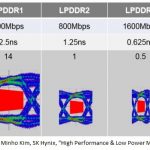IMEC is a technology research center located in Belgium that is one of the premier semiconductor research centers in the world today. The IMEC Technology Forum (ITF) is a two-day event attended by approximately 1,000 people to showcase the work done by IMEC and their partners.… Read More
Tag: dram
Arteris Unveils Solution for Heterogeneous Cache Coherent SOC’s
Designing SOC’s for markets like automotive and mobile electronics requires taking advantage of every opportunity for optimization. One way to do this is through building a cache coherent system to boost speed and reduce power. Recently, NXP decided to go about this on their automotive MCU based SOC’s by using Arteris’ just-announced… Read More
Yelling fire in a crowded chip factory
Semiconductor market forecasts for 2016 are all over the place. Jim Handy and Tom Starnes floated a report in January looking for 10% growth. Jim Feldhan at Semico turned outright negative at -0.3% just a couple weeks ago. Tossing out the high and low scores, analysts tracked by GSA range from 0.3% to 7.0% in March updates. What’s … Read More
DDR4 is a complex interface to verify — assistance needed!
The design of parallel interfaces is supposed to be (comparatively) easy — e.g., follow a few printed circuit board routing guidelines; pay attention to data/clock/strobe signal lengths and shielding; ensure good current return paths (avoid discontinuities); match the terminating resistances to the PCB trace impedance;… Read More
Inception of "Intel Inside"
Let me start with a quote:
“Competition is always a good thing. It forces us to do our best. A monopoly renders people complacent and satisfied with mediocrity.”– Nancy Pearcy
By the end of post, it will be quite evident that it was the competition that led to one of the classiest campaign “Intel Inside” for its processors. As I mentioned… Read More
Japan..silent but strong players of semiconductor industry
Japanese stood to be the world leaders during 1980-1990 regime in semiconductor manufacturing[SUP] [2][/SUP]. During my research, I found that Japanese semiconductor firms are very strong leaders in process which gave them a competitive advantage over others. Situation is bit different today, as we have fabless firms taking… Read More
Micron Misses (MU) – No surprise – Needs focus on NAND/XPoint not diving DRAM
We are surprised that everyone is surprised at DRAM, DRAM oversupply/weak demand is systemic so Micron needs to focus on NAND/XPoint.We find it somewhat amusing that many “analysts” were caught off guard about the weakness in Microns results and poor guidance. Why would you think DRAM would be OK???…Have … Read More
IEDM Blogs – Part 2 – Memory Short Course
Each year the Sunday before IEDM two short courses are offered. This year I attended Memory Technologies for Future Systems held on Sunday, December 6[SUP]th[/SUP]. I have been to several of these short courses over the years and they are a great way to keep up to date on the latest technology.… Read More
Samsung to cut Semi Capex 20% due to over capacity
Article confirms market fears…
An article in the Korea Times cites sources that say Samsung will cut Semi Capex by 20% due to current oversupply and weak pricing. This is obviously a huge negative as Capex for 2016 will certainly be down significantly from 2015 given these cuts which follow on cuts by Intel and others. We can… Read More
3D Xpoint and the Future of Memory
Recently Intel and Micron announced a new three dimensional cross point (3D Xpoint) memory. The 3D Xpoint announcement has generated a lot of questions and interest in what this new memory is and where it may fit in the semiconductor market. … Read More


